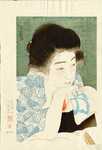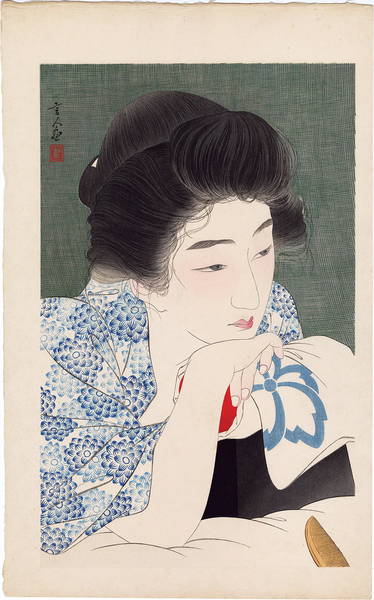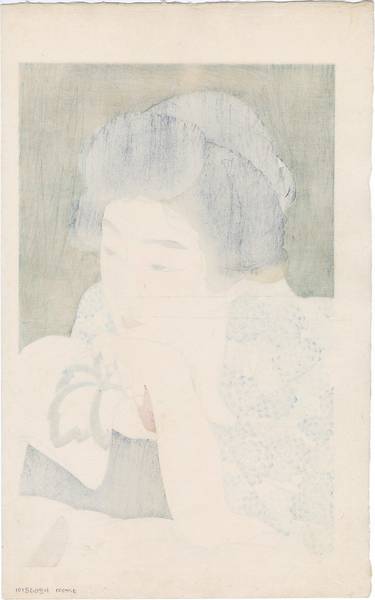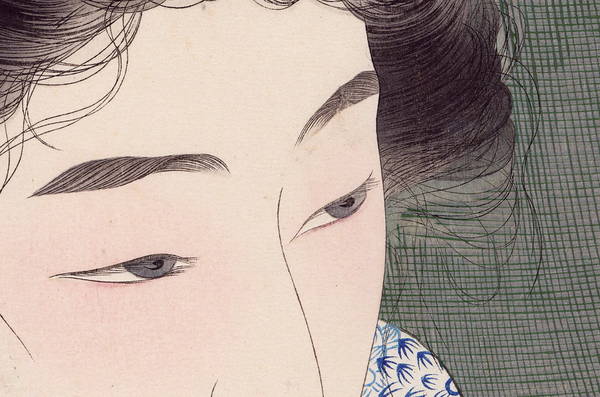| | |
| Artist: | Torii Kotondo (1900-1976) — 鳥居言人 |
| Title: | Morning Hair - Asa Negami — 朝寝髪 |
| Series: | |
| Date of first edition?: | 1931/11 |
| Publisher (first edition)?: | Ikeda — 池田 |
| Publisher (this edition)?: | Ikeda — 池田 |
| Medium (first edition): | Woodblock |
| Medium (this edition): | Woodblock |
| Format (first edition): | Large Oban
|
| Format (this edition): | Large Oban |
| DB artwork code: | 47318 |
| Notes (first edition)?: |
Artist Torii Kotondo (1900-1976)
Title: Morning Hair
Date Of Work: 1931 November (confirmed)
Publisher: Ikeda
Dimensions: 19 x 11.75 inches
Limited edition of only 100 prints, after which the blocks were destroyed.
Scene number 1 among 12 Ikeda published scenes.
Notes: Very rare. Kotondo's most famous design. The police banned this scene under the "Peace Preservation Law" of 1928, and confiscated the prints and blocks after 70 impressions had been printed. Why? Because of that comb in the lower right corner (too sexually suggestive. Go figure!). Ikeda marked all unsold prints with an X, gouged the blocks, and then handed them into the police (the above data is from the publisher Ikeda Tomizo's brother). So this means the actual number of prints that were sold is extremely low - maybe 30 or less, as we would expect given the rarity of this scene. To date the highest edition number I have confirmed is no. 28, so I think my estimate of 30 prints in circulation is likely.
Re-issued in the series "Twelve Aspects of Women" circa August 23, 1988. |
|
| Notes (this edition)?: |
| The following information was taken from the original web listing of this artwork. Note that there may be some inaccuracies:
TITLE: Morning Hair
DATE: 1930
SIZE: 19 x 11.75
MEDIUM: Woodblock Print
PUBLISHER: Ikeda
CONDITION: Fine impression, color and condition.
Edition number unknown. This example is another un-editioned strike.
Thanks to Egenolf Gallery for further images of this print and this write-up:
Artist: Torii Kotondo (1900-1976)
Title: Morning Hair 朝寝髪 (Asanegami)
Date: Ca. 1930
Intimate portrait of a young woman who has just woken up and is alone with her thoughts; presumably they turn towards her absent lover. The mosquito net that forms the background indicates that it is summer, and her tousled hair and separated comb indicate that she has just woken up, following a night spent with her lover. The title “asanegami” literally translates as “hair (kami) of a late riser (asane)”. The term appears in Japanese poetry as early as the 8th century anthology Manyôshû, “Collection of Ten-thousand Leaves”. Although tastefully suggestive to the modern viewer, the early Showa-period authorities found this work so salacious that they confiscated the publisher’s remaining stock of 30 published prints, leading to the extraordinary rarity of this design, as only 70 were ever sold. The blocks were carved by Maeda Kentaro, considered to be a master carver of his generation. This work is considered one of the masterpieces of shin hanga, as well as Kotondo’s finest design. Chosen as the cover image for the important 1993 book on the Muller Collection, “The new wave”.
Condition: Excellent impression, color and condition.
Publisher: Ikeda
Literature: See “The new wave”, cover and number 268, page 202. See The Toledo Museum of Art (1936), number 133. See the Art Institute of Chicago
Signature: Kotondo ga
Size: 48.2 x 29.8 cm |
|
| Artist Bio: |
| Torii Kotondo (or Torii Kiyotada VIII) is renowned for his paintings and shin hanga prints of beautiful women. His woodblock prints, superbly carved and printed, are comparable with those of Hashiguchi Goyo and Ito Shinsui. Kotondo was born with the name Saito Akira in the Nihonbashi district of Tokyo. He was the only son among the five children of Torii Kiyotada, the seventh Torii master. The Torii school had a long tradition of painting and printmaking for the Japanese theater, extending back to the seventeenth century. Kabuki theater was still very popular in the early twentieth century and prints and painted posters were the primary means of publicity. Although Kotondo was mainly interested in studying history and archaeology, it was assumed that he would follow in his father's footsteps and join the Torii school. At age 14, Kotondo agreed to leave school and begin studies with Kobori Tomone, a yamato-e painter. Along with painting classes, Tomone taught Kotondo about the court and military practices of ancient Japan, satisfying his interest in history. A year later, he was officially adopted as the next heir of the Torii school and assumed the artist's name 'Kotondo'. While still studying with Tomone, he began designing illustrations for a theatrical magazine, Engei Gaho ('Entertainment Illustrated Magazine'), and painted kabuki posters and billboards. Torii Kotondo was the 8th Torii and the 5th Torii Kiyotada. His father was the 4th Kiyotada.
|
|























